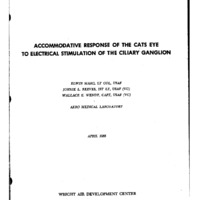-
Title
-
Accommodative Responses Of The Cats Eye To Electrical Stimulation Of The Ciliary Ganglion
-
Date
-
1955
-
Index Abstract
-
Not Available
-
Photo Quality
-
Not Needed
-
Report Number
-
WADC TR 54-508
-
Corporate Author
-
Air Force Aerospace Medical Research Laboratory
-
Laboratory
-
Aero Medical Laboratory
-
Extent
-
20
-
NTRL Accession Number
-
AD075817
-
Identifier
-
AD0075817
-
Access Rights
-
Unknown
-
Distribution Classification
-
1
-
DTIC Record Exists
-
No
-
Distribution Change Authority Correspondence
-
AFWAL LTR
-
Abstract
-
The purpose of this study was to obtain background information on the neural innervation of accomodation of the eye. This was obtained by electrically stimulating the ciliary ganglion in cats with biphasic pulses of varying voltage and frequency from a Grass stimulator, and measuring the refractive state of the eye with an eye refractometer (Rodenstock). Varying the electromotive force (EMF) of the stimulus produces a graded response, presumably by the number of fibers made active (spatial summation). Varying the frequency of the stimulus (temporal summation) produced a threshold reponse at about 4 cycles per second and a linearly graded response from 20 to 35 cycles, depending on the EMF, after which it remained constant. The slope of the linear frequency response (frequency sensitivity) increase with the EMF. Within a certain central range of frequency and EMF, either of the parameters may be substituted for the other to provide a given level of accomodative response. A fifteen year old cat also was studied and the accomodative reponse to the electrical stimulation of the ciliary ganglion was measured and graphed. The accomodative amplitude of the aged cat was found to be lower than the mean amplitude of a group of young cats, but not significantly so. The cat was estimated to have an age equivalent to a man of 75-90 years. Since man shows little or no accomodative amplitude (absolute presbyopia) at this age, it is apparent that no similar phenomenon occurred in the aged cat. Evidence is offered to support the Hess theory of a physiological reserve of accomodative amplitude. The significance of the findings in relation to the ratio between accomodative convergence and accomodation (AC/A) is discussed.
-
Report Availability
-
Full text available
-
Date Issued
-
1955-04
-
Provenance
-
Hunt Library, Embry-Riddle Aeronautical University
-
Type
-
report
-
Format
-
1 online resource
-
Creator
-
Marg, Elwin
 WADCTR54-508.pdf
WADCTR54-508.pdf